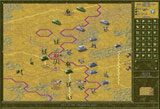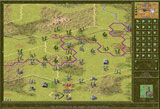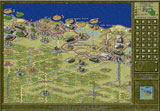 The Operational Art of War: Wargame of the
Year Edition is Talonsoft’s celebration of Norm Koger’s The Operational Art of
War, Volume 1: 1939-1955. Norm Koger is to wargamers what John Carmack is to
Quakeheads—a terrific designer with a hardcore legion of fans. And though he was
already well-respected in wargaming circles from his wonderful Age of Rifles (man, talk
about a game I’d like to see updated) it was only with the release of TOAW back in
1998 that he became the gaming press’ spokesman-at-large for the grognard community. And with good reason, too; TOAW was a very strong
game. With a sturdy, deep and versatile engine that could model just about every World War
II battle as well as a user-friendly editor that allowed the hardcore to create and post
their own scenarios, TOAW was a big hit with gamers and the critics alike. Wargame of the Year awards poured in from just
about every major publication. Since then, Talonsoft has supported the engine by following
up with TOAW: Volume 2, 1956-2000 and with add-on packs for each of the games. Given the
marginal status of the wargaming genre in the computer gaming world, one rarely sees a
wargame spawn any sort of sequel. So it’s a testament to TOAW’s overall
excellence that Talonsoft has managed to squeeze four additional products out of the game. The Operational Art of War: Wargame of the
Year Edition is Talonsoft’s celebration of Norm Koger’s The Operational Art of
War, Volume 1: 1939-1955. Norm Koger is to wargamers what John Carmack is to
Quakeheads—a terrific designer with a hardcore legion of fans. And though he was
already well-respected in wargaming circles from his wonderful Age of Rifles (man, talk
about a game I’d like to see updated) it was only with the release of TOAW back in
1998 that he became the gaming press’ spokesman-at-large for the grognard community. And with good reason, too; TOAW was a very strong
game. With a sturdy, deep and versatile engine that could model just about every World War
II battle as well as a user-friendly editor that allowed the hardcore to create and post
their own scenarios, TOAW was a big hit with gamers and the critics alike. Wargame of the Year awards poured in from just
about every major publication. Since then, Talonsoft has supported the engine by following
up with TOAW: Volume 2, 1956-2000 and with add-on packs for each of the games. Given the
marginal status of the wargaming genre in the computer gaming world, one rarely sees a
wargame spawn any sort of sequel. So it’s a testament to TOAW’s overall
excellence that Talonsoft has managed to squeeze four additional products out of the game.
For those of you not familiar with the
game, TOAW is essentially a PC translation of hexagon-and-counter turn-based Igo-Ugo
boardgames. As the title suggests, it models battles at the operational level, which takes
in a lot of room—essentially everything between the squad-level tactics of Close
Combat and grand strategy of, oh, say, Third Reich. Scenarios run from battles as small as
Dien Bien Phu to as large as Operation Barbarossa. While the graphics are attractive
(especially by wargame standards) there’s nothing here that will blow out your
eyeballs. If you’re expecting Starcraft in Normandy, you might want to steer clear of
this one; if you’re the kind of person who knows about The Gamers and GMT and still
mourns the demise of the real Avalon Hill, TOAW is your sort of game.
 Which brings me to a point I’d like to make about the Wargame
of the Year Edition (in fact, about all the TOAW series)—it’s not very
beginner-friendly. This doesn’t need to be the case. While the game is deep and
detailed, it’s not really all that complex. But you’d never know that from the
manual, which is much more intimidating than it should be. For example, it assumes that
anyone who picks up the game is going to be familiar with almost every traditional
hex-based wargaming convention. If you are, you won’t have much problem catching on
to the game’s mechanics; if you aren’t, you’ll be at sea by page 9. While
there is a tutorial, it’s located at the very back of the lengthy manual and runs
only 17 pages—in contrast, the appendix on equipment data runs for 26, and the
section on scenario creation for 40. This isn’t to say that the hardcore information
contained in the manual isn’t welcome; it’s just to suggest that the game’s
documentation is perhaps too slanted towards the hardcore wargamer. And that’s a
shame; this is an excellent, exciting, and playable wargame. A manual that included a good
introduction to wargame mechanics and concepts would go a long way toward introducing
newbies to the genre. Which brings me to a point I’d like to make about the Wargame
of the Year Edition (in fact, about all the TOAW series)—it’s not very
beginner-friendly. This doesn’t need to be the case. While the game is deep and
detailed, it’s not really all that complex. But you’d never know that from the
manual, which is much more intimidating than it should be. For example, it assumes that
anyone who picks up the game is going to be familiar with almost every traditional
hex-based wargaming convention. If you are, you won’t have much problem catching on
to the game’s mechanics; if you aren’t, you’ll be at sea by page 9. While
there is a tutorial, it’s located at the very back of the lengthy manual and runs
only 17 pages—in contrast, the appendix on equipment data runs for 26, and the
section on scenario creation for 40. This isn’t to say that the hardcore information
contained in the manual isn’t welcome; it’s just to suggest that the game’s
documentation is perhaps too slanted towards the hardcore wargamer. And that’s a
shame; this is an excellent, exciting, and playable wargame. A manual that included a good
introduction to wargame mechanics and concepts would go a long way toward introducing
newbies to the genre.
And as long as I’m kvetching,
I’m still baffled by the game’s 3D view. While this view works very well (and
looks better) in Talonsoft’s West Front and East Front games, it seems a curious and
underdeveloped option in TOAW, where the 2D view is very tidy and (unlike the 3D view)
provides the information you need. If the 3D view is an attempt to lure non-wargamers into
the genre by providing “toy soldier” eye candy, I’d suggest the time would
be better spent on that manual.
 The Game of the Year Edition contains a bunch of scenarios,
including all the scenarios from the original game, as well as those from the Battle Pack
One add-on and about a dozen new ones. That’s over 40 scenarios, and as in the
Flashpoint: Kosovo Battle Pack for TOAW II, there’s a real trend towards what the
designers call “huge” scenarios and what we old-timers used to call
“monster games”. The new scenarios include the North African Campaign, Cherbourg
’44, the Falaise Pocket, Greece ‘40-41, Malta ’42, Mortain, Operation
Olympic, Overlord, and Operation Uranus. Though TOAW fans who have both the original game
and the add-on pack may balk at paying fifty bucks for less than a dozen new scenarios
(especially given the enormous number downloadable on web sites), I like to think of it
this way: I’ve paid fifty dollars for board games of one battle. Fifty bucks
for about a dozen seems a pretty reasonable price.
And it's just come to my attention that Talonsoft is offering a discount on the game for
anyone who already owns TOAW Volume One, the first Battle Pack, or the Elite Edition of
TOAW. Check out the details at their website--www.talonsoft.com. The Game of the Year Edition contains a bunch of scenarios,
including all the scenarios from the original game, as well as those from the Battle Pack
One add-on and about a dozen new ones. That’s over 40 scenarios, and as in the
Flashpoint: Kosovo Battle Pack for TOAW II, there’s a real trend towards what the
designers call “huge” scenarios and what we old-timers used to call
“monster games”. The new scenarios include the North African Campaign, Cherbourg
’44, the Falaise Pocket, Greece ‘40-41, Malta ’42, Mortain, Operation
Olympic, Overlord, and Operation Uranus. Though TOAW fans who have both the original game
and the add-on pack may balk at paying fifty bucks for less than a dozen new scenarios
(especially given the enormous number downloadable on web sites), I like to think of it
this way: I’ve paid fifty dollars for board games of one battle. Fifty bucks
for about a dozen seems a pretty reasonable price.
And it's just come to my attention that Talonsoft is offering a discount on the game for
anyone who already owns TOAW Volume One, the first Battle Pack, or the Elite Edition of
TOAW. Check out the details at their website--www.talonsoft.com.
Of course, not all the scenarios are
winners. This is especially true if
you’re playing against the computer, which is not bad at defending but pretty awful
at sustaining any sort of offensive. For example, in the Dien Bien Phu scenario my French
busted up a couple of early Viet Minh assaults. After that, the Reds just refused to
attack, and the last ten game turns played out with my forces sitting in their bunkers
staring at the Viet Minh, who just stared back. Nice way to end the war, but not very
historical. On the other hand, some of the scenarios are just killer--the North Africa and
the Falaise Pocket scenarios alone are worth the price of admission.
So what’s the final call on The
Operational Art of War: Game of the Year Edition? Well, if you’ve got TOAW and Battle
Pack One, you’ll have to make the call yourself—but I’d say the additional
“monster game” scenarios and improved editor make it worth picking up. If
you’re a wargamer who hasn’t played TOAW yet, I’d say buy it now. As for
me, well, I consider this to be the ultimate edition of one of my favorite games of all
time. For all my quibbles, if I had to choose five games to take on a desert island with
me, this would be one of them.
--Rick
Fehrenbacher |
